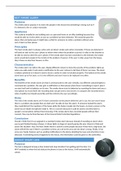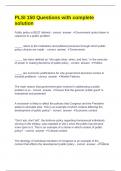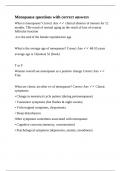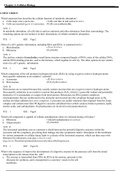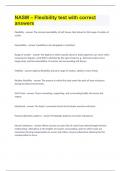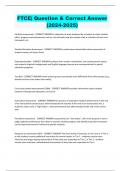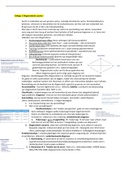Concise notes for addiction and the brain revision
Part A: Chemical transmission between neurons
• We are susceptible to drugs like alcohol and heroin due to psychotropic drugs
mimicking and interfering with the normal processes of chemical communication
between brain cells.
• Classical neurotransmitters involved in addiction are dopamine (indirectly released
by drugs like amphetamine and cocaine), noradrenalin (also indirectly released by
drugs like amphetamines and cocaine), serotonin ( 5 HT increased by drug
ecstasy/MDMA) and acetylcholine (has receptors activated by drug nicotine)
• Neurotransmitters exist due to communication of neurons between nerve cells (up
to 1m distance).
• Neural signals travel electronically along axons/nerve fibres
• At the terminal (end of axon) is the synapse which must be crossed to reach next
neuron.
• Chemical neurotransmitters are stored in synaptic vesicles and when released, cross
the synaptic cleft by a process of diffusion.
• On other side of synaptic cleft are receptors configured to recognise the key
neurotransmitter which recognise the key neurotransmitter which unlocks
postsynaptic response as an agonist.
• Autoreceptors, found presynaptically at neuron terminal, as well as on cell bodies
where electrical signals originate, act like thermostats (regulate neurotransmitter
release and neuronal firing at neuron terminal and cell body)
• Neurotransmitters (drugs) acting at autoreceptors can reduc further release at
terminal or firing from the cell body so that neurotransmission is overall reduced.
• Synapses also reveal additional mechanisms by which drugs can have a net psotive
or negative effect on synaptic transmission. E.g acting as a precursor or raw
ingredient for neurotransmitter synthesis within the neuron (+) by inhibiting
synthesis in the vesicles (-).
• The consequence from above will depend on whether drug action has the net effect
to increase (+ as an indirect antagonist) or decrease (- as a functional antagonist)
neurotransmission.
• Drugs can have diverse effects which sometimes cancel eachother out e.g.
amphetamines stimulate release of dopamine and norarenalin, cocaine blocks
reuptake of dopamine noradrenalin)
Part B: Evidence for role of neurotransmission in addiction
• MDMA is known to increase serotonergic (5 HT) function in sort term. In longer
term, with prolonged use, evidence shows serotonin can become depleted indicating
neurotoxicity resulting in cell death in serotonergic pathways.
• Ways of measuring serotonergic function indirectly in human drug users is by giving
a challenge test. E.g. fenfluramine increases serotonin release and increased
, serteonin in turn has an effect on the pituitary which is shown as a hormonal change
(specifically the prolactin response).
• MDMA users show a reduced prolactin response to fenfluramine challenge, which
suggests that their serotonergic function is depressed (Gerra et al, 2000).
• This reduced response to fenfluramine challenge persists in abstinent users suggest
there may be long term effects of long-term use, evidence consistent with
neurotoxicity (as if change were just functional, some recovery would be expected
when drug use is discontinued)
• Controlled studies with animals also very informative
• Interaction between social stress and psychostimulant use also been investigated in
animals.
• Studies of human drug users have many confounds and uncontrolled variables e.g.
high levels of self-reported stress could be a cause of or consequence of drug
addiction. Lab rats trained to press a elver for cocaine infusion or food reward.
• Social stress can be produced experimentally by being placed in home cage of
another male for 60 min. male intruders would normally be attacked and so wire
mesh is used to protect them. After social stess induction, rats showed increased
responding for cocaine but not food reward and at both 0.125mg and half that dose
(Miczeck & Mutschler, 1996).
• The above shows a selective effect of social stress on cocaine reinforced responding,
maintained also at a lower dose as before the social stress levels of responding for
food and cocaine were equal. Suggesting psychostimulants are very powerful
rewards, as rewarding as food for a hungry anaimal and more rearding as food for a
stressed animal.
• Consistent with the findings clinical reports suggest role of stressful life events in the
relapse of human drug users, but these studies are correlational, controlled animal
studies (such as those conducted by Miczeck & Mutschler 1996)are needed to show
cause and effect.
• The above studies are known as psychopharmacology studies to show evidnce linked
to drug use to neurotransmitter function.
• Stress also has well-documented effects on the brain dopamine system which
normally deals with reward and may be ‘hijacked’ by drugs of abuse (Nora Volkow)
Catecholamines
Part A: Catecholamines
• DA and NA modulate different psychological effects: DA increase associated more
with reward and excitement, NA increase associated with more alertness and
arousal. Hwvr, as they have similar chemical structure theyre both considered
catecholamines.
• Both DA and NA are synthesized from same raw ingredients (initially tyrosine
converted to DOPA by enzyme tyrosine hydroxylase).
• NA converted from DA in last step of pathway by enzyme dopamine ß-hydroxylase
which is only found in NA neurons. (as isn’t needed to produce DA)
,• They both, as well as precursor DOPA, share some structural features which explains
why they share functional characteristics.
• Depletion of catecholamines can be produced experimentally by treatment with
reserpine and results in behavioural sedation reserpine and results in behavioural
sedation. This can be reversed by treatment with DOPA to synthesise DA and NA.
• ^^ this restoration confirms importance of catecholamines in behavioural sedation
but doesn’t tell us whether DA or NA is most important.
• Reserpine isn’t a drug of abuse but even when we know how to reverse a drug effect
this may not tell us how the effect was mediated (same kind of follow up diagnostic
approaches used to identify specific mechanisms of action of addictive drugs).
• Matching structural features shown in synthesis pathways explain categorisation of
DA and NA as catecholamines.
• The lock and key analogy for drug action – a perfect fit at a drug receptor intended
for a naturally occurring neurotransmitter results in an agonist action, mimicking
that of a neurotransmitter itself (or at least for that particular receptor sub type)
• Different kinds of post synaptic receptor (DA DA1 AND DA DA2) provide functional
specificity to the signalling.
• DA acts at both these receptor families but different kinds of drug have different
levels of affinity for DA DA1 vs DA2.
• Different receptor families lend an extra dimension to info value in the signalling,
further functional specificity come from particular DA pathway in which neurons are
situated.
• DA is most strongly implicated in addiction and a variety of drugs with diverse other
effects turn out to act as indirect DA agonists e.g. cannabis (Bloomfield, 2016) or (in
addition to other actions) to directly stimulate DA neurons e.g. inhalants (Reigal et
al, 2017)
, Part 2B: Key brain pathways
• There are 3 ascending DA pathways:
o the nigrostriatal pathway (from substantia nigra to caudate putamen) which
is damaged in Parkinson’s disease (and by chronic use of psychomotor
stimulants)
o the mesolimbic pathway (from ventral tegmental area to nucleus accumbens)
implicated in reward and drug abyse
o the mesocortical pathway (from ventral tengmental area to cerebral cortex)
implicated in schizophrenia (and schizophrenia like symptoms can be a side
effect of using amphetamines)
• the dopaminergic mesolimbic pathway is particularly implicated in drug abuse.
• lesion studies show the effects of damage to nigrostriatal pathway – experimental
damage on one side, produced by injection of a toxin, causes visible degeneration of
DA neurons (shown using an antibody for tyrosin hydroxylase).
• Without any staining, loss of DA cells can still be seen in post mortem brains of
patients who had parkinon’s disease.
• In living patients, imaging studies have shown that the loss of DA innervation of
striatum is systematically related to symptom severity in parkinson’s disease (DA is
imaged using labelled drug which binds to DA transporter ; Fishman et al, 1988)
• The sever motor disorder catalepsy, has been further identified with DA DA2
receptor, because can be experimentally induced by treatment with DA DA2
antagonist haloperidol in a rat model.
• Haloperidol used to control symptoms of Schz but produces unwanted motor
symptoms as a side effect.
• Drug addicts can also show similar profiles of motor disturbances after long term use
of drugs, particularly psychomotor stimulants, chronic use of which can exhaust and
ultimately damage their DA systems.
• Conversely when DA activity is high in nigrostriatal and mesocortical pathways,
agitation and schz like symptoms may be seen.
• Na pathways originate in Locus Coeruleus (LC) which projects to almost all regions of
forebrain, as well as cerebellum and spinal cord. LC firing is activated by arousing
sensory stimuli and inhibited during the performance of maintenance behaviours
such as sleeping, grooming and consuming food, hence its hypothesized role in
vigilance/ attentiveness to important external stimuli. (Aston-Jones, 1985)
Part C: Key receptor sub-types
• Further animal models use genetically modified mice to analyse role of DA receptor
subtypes in different behaviours e.g. mice can be bred with genes need to code for
DA transporter ‘knocked out’. Meaning they’ve lost an important regulatory
mechanism to control levels of DA with the synaptic cleft.
• The homozygous mice have double dose of this deletion and show increased
locomotor activity (measured as photobeam breaks)compared to genetically normal
or heterozygous mice, htgous mice retain normal function (Giros, et al, 1996)
Part A: Chemical transmission between neurons
• We are susceptible to drugs like alcohol and heroin due to psychotropic drugs
mimicking and interfering with the normal processes of chemical communication
between brain cells.
• Classical neurotransmitters involved in addiction are dopamine (indirectly released
by drugs like amphetamine and cocaine), noradrenalin (also indirectly released by
drugs like amphetamines and cocaine), serotonin ( 5 HT increased by drug
ecstasy/MDMA) and acetylcholine (has receptors activated by drug nicotine)
• Neurotransmitters exist due to communication of neurons between nerve cells (up
to 1m distance).
• Neural signals travel electronically along axons/nerve fibres
• At the terminal (end of axon) is the synapse which must be crossed to reach next
neuron.
• Chemical neurotransmitters are stored in synaptic vesicles and when released, cross
the synaptic cleft by a process of diffusion.
• On other side of synaptic cleft are receptors configured to recognise the key
neurotransmitter which recognise the key neurotransmitter which unlocks
postsynaptic response as an agonist.
• Autoreceptors, found presynaptically at neuron terminal, as well as on cell bodies
where electrical signals originate, act like thermostats (regulate neurotransmitter
release and neuronal firing at neuron terminal and cell body)
• Neurotransmitters (drugs) acting at autoreceptors can reduc further release at
terminal or firing from the cell body so that neurotransmission is overall reduced.
• Synapses also reveal additional mechanisms by which drugs can have a net psotive
or negative effect on synaptic transmission. E.g acting as a precursor or raw
ingredient for neurotransmitter synthesis within the neuron (+) by inhibiting
synthesis in the vesicles (-).
• The consequence from above will depend on whether drug action has the net effect
to increase (+ as an indirect antagonist) or decrease (- as a functional antagonist)
neurotransmission.
• Drugs can have diverse effects which sometimes cancel eachother out e.g.
amphetamines stimulate release of dopamine and norarenalin, cocaine blocks
reuptake of dopamine noradrenalin)
Part B: Evidence for role of neurotransmission in addiction
• MDMA is known to increase serotonergic (5 HT) function in sort term. In longer
term, with prolonged use, evidence shows serotonin can become depleted indicating
neurotoxicity resulting in cell death in serotonergic pathways.
• Ways of measuring serotonergic function indirectly in human drug users is by giving
a challenge test. E.g. fenfluramine increases serotonin release and increased
, serteonin in turn has an effect on the pituitary which is shown as a hormonal change
(specifically the prolactin response).
• MDMA users show a reduced prolactin response to fenfluramine challenge, which
suggests that their serotonergic function is depressed (Gerra et al, 2000).
• This reduced response to fenfluramine challenge persists in abstinent users suggest
there may be long term effects of long-term use, evidence consistent with
neurotoxicity (as if change were just functional, some recovery would be expected
when drug use is discontinued)
• Controlled studies with animals also very informative
• Interaction between social stress and psychostimulant use also been investigated in
animals.
• Studies of human drug users have many confounds and uncontrolled variables e.g.
high levels of self-reported stress could be a cause of or consequence of drug
addiction. Lab rats trained to press a elver for cocaine infusion or food reward.
• Social stress can be produced experimentally by being placed in home cage of
another male for 60 min. male intruders would normally be attacked and so wire
mesh is used to protect them. After social stess induction, rats showed increased
responding for cocaine but not food reward and at both 0.125mg and half that dose
(Miczeck & Mutschler, 1996).
• The above shows a selective effect of social stress on cocaine reinforced responding,
maintained also at a lower dose as before the social stress levels of responding for
food and cocaine were equal. Suggesting psychostimulants are very powerful
rewards, as rewarding as food for a hungry anaimal and more rearding as food for a
stressed animal.
• Consistent with the findings clinical reports suggest role of stressful life events in the
relapse of human drug users, but these studies are correlational, controlled animal
studies (such as those conducted by Miczeck & Mutschler 1996)are needed to show
cause and effect.
• The above studies are known as psychopharmacology studies to show evidnce linked
to drug use to neurotransmitter function.
• Stress also has well-documented effects on the brain dopamine system which
normally deals with reward and may be ‘hijacked’ by drugs of abuse (Nora Volkow)
Catecholamines
Part A: Catecholamines
• DA and NA modulate different psychological effects: DA increase associated more
with reward and excitement, NA increase associated with more alertness and
arousal. Hwvr, as they have similar chemical structure theyre both considered
catecholamines.
• Both DA and NA are synthesized from same raw ingredients (initially tyrosine
converted to DOPA by enzyme tyrosine hydroxylase).
• NA converted from DA in last step of pathway by enzyme dopamine ß-hydroxylase
which is only found in NA neurons. (as isn’t needed to produce DA)
,• They both, as well as precursor DOPA, share some structural features which explains
why they share functional characteristics.
• Depletion of catecholamines can be produced experimentally by treatment with
reserpine and results in behavioural sedation reserpine and results in behavioural
sedation. This can be reversed by treatment with DOPA to synthesise DA and NA.
• ^^ this restoration confirms importance of catecholamines in behavioural sedation
but doesn’t tell us whether DA or NA is most important.
• Reserpine isn’t a drug of abuse but even when we know how to reverse a drug effect
this may not tell us how the effect was mediated (same kind of follow up diagnostic
approaches used to identify specific mechanisms of action of addictive drugs).
• Matching structural features shown in synthesis pathways explain categorisation of
DA and NA as catecholamines.
• The lock and key analogy for drug action – a perfect fit at a drug receptor intended
for a naturally occurring neurotransmitter results in an agonist action, mimicking
that of a neurotransmitter itself (or at least for that particular receptor sub type)
• Different kinds of post synaptic receptor (DA DA1 AND DA DA2) provide functional
specificity to the signalling.
• DA acts at both these receptor families but different kinds of drug have different
levels of affinity for DA DA1 vs DA2.
• Different receptor families lend an extra dimension to info value in the signalling,
further functional specificity come from particular DA pathway in which neurons are
situated.
• DA is most strongly implicated in addiction and a variety of drugs with diverse other
effects turn out to act as indirect DA agonists e.g. cannabis (Bloomfield, 2016) or (in
addition to other actions) to directly stimulate DA neurons e.g. inhalants (Reigal et
al, 2017)
, Part 2B: Key brain pathways
• There are 3 ascending DA pathways:
o the nigrostriatal pathway (from substantia nigra to caudate putamen) which
is damaged in Parkinson’s disease (and by chronic use of psychomotor
stimulants)
o the mesolimbic pathway (from ventral tegmental area to nucleus accumbens)
implicated in reward and drug abyse
o the mesocortical pathway (from ventral tengmental area to cerebral cortex)
implicated in schizophrenia (and schizophrenia like symptoms can be a side
effect of using amphetamines)
• the dopaminergic mesolimbic pathway is particularly implicated in drug abuse.
• lesion studies show the effects of damage to nigrostriatal pathway – experimental
damage on one side, produced by injection of a toxin, causes visible degeneration of
DA neurons (shown using an antibody for tyrosin hydroxylase).
• Without any staining, loss of DA cells can still be seen in post mortem brains of
patients who had parkinon’s disease.
• In living patients, imaging studies have shown that the loss of DA innervation of
striatum is systematically related to symptom severity in parkinson’s disease (DA is
imaged using labelled drug which binds to DA transporter ; Fishman et al, 1988)
• The sever motor disorder catalepsy, has been further identified with DA DA2
receptor, because can be experimentally induced by treatment with DA DA2
antagonist haloperidol in a rat model.
• Haloperidol used to control symptoms of Schz but produces unwanted motor
symptoms as a side effect.
• Drug addicts can also show similar profiles of motor disturbances after long term use
of drugs, particularly psychomotor stimulants, chronic use of which can exhaust and
ultimately damage their DA systems.
• Conversely when DA activity is high in nigrostriatal and mesocortical pathways,
agitation and schz like symptoms may be seen.
• Na pathways originate in Locus Coeruleus (LC) which projects to almost all regions of
forebrain, as well as cerebellum and spinal cord. LC firing is activated by arousing
sensory stimuli and inhibited during the performance of maintenance behaviours
such as sleeping, grooming and consuming food, hence its hypothesized role in
vigilance/ attentiveness to important external stimuli. (Aston-Jones, 1985)
Part C: Key receptor sub-types
• Further animal models use genetically modified mice to analyse role of DA receptor
subtypes in different behaviours e.g. mice can be bred with genes need to code for
DA transporter ‘knocked out’. Meaning they’ve lost an important regulatory
mechanism to control levels of DA with the synaptic cleft.
• The homozygous mice have double dose of this deletion and show increased
locomotor activity (measured as photobeam breaks)compared to genetically normal
or heterozygous mice, htgous mice retain normal function (Giros, et al, 1996)

